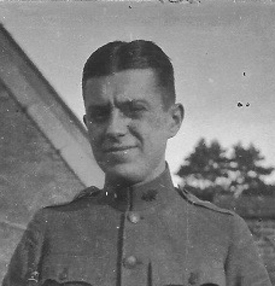(Indianapolis, Indiana, March 31, 1895 – San Francisco, California, October 26, 1979).1
Oxford & Grantham ✯ Training to fly ✯ France and No. 206 Squadron ✯ July 29, 1918 ✯ Late July, August, and September 1918 at 206 ✯ Issoudun, the 91st Aero, and home
On his mother’s side, Harry Adam Schlotzhauer, Jr., was of Irish descent; on his father’s, both grandparents were born in Saxony and came independently to Indiana, where they married in 1854. Their son, Harry Adam Schlotzhauer, Sr., was born there and, in 1890, he married Sarah Curran Pye, also born in Indiana. Schlotzhauer, Sr., became a well-known banker, and he and his wife were socially prominent in Indianapolis. Harry Adam Schlotzhauer, Jr., was their only child.2
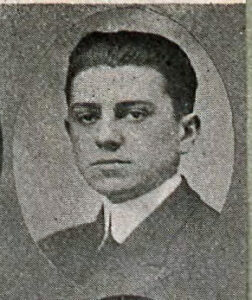
Schlotzhauer attended Shortridge High School in Indianapolis where he excelled in basketball (he was tall) and tennis, as well as debate.3 After graduating in 1911 he attended Phillips Andover with the class of 1913.4 At Phillips he was registered in the classical department, but when he went on to Yale he enrolled in Sheffield Scientific School and studied electrical engineering, graduating in 1915.5
After working for a time in New York for Buffalo Copper & Brass Rolling Mill, Schlotzhauer moved to Chicago and, like his father, went into finance.6 When he registered for the draft he was working for Merrill Fox & Co., commercial paper brokers in Chicago.7 He enlisted on June 21, 1917, and evidently applied to and was accepted by the Aviation Section of the Signal Corps.8 He attended ground school at the University of Illinois’s School of Military Aeronautics, graduating September 1, 1917.9
Along with most of the men from his ground school class of about thirty, Schlotzhauer chose or was chosen to go to Italy for flying training and thus sailed with the 150 cadets of the “Italian” or “second Oxford detachment” to England on the Carmania. They departed New York on September 18, 1917, bound initially for Halifax, where they joined a convoy that set off across the Atlantic on September 21, 1917. The men of the detachment travelled first class and had plenty of leisure, apart from Italian lessons given by Fiorello La Guardia, who was travelling with them, and, once they entered dangerous coastal waters, submarine watch duty.
Oxford and Grantham
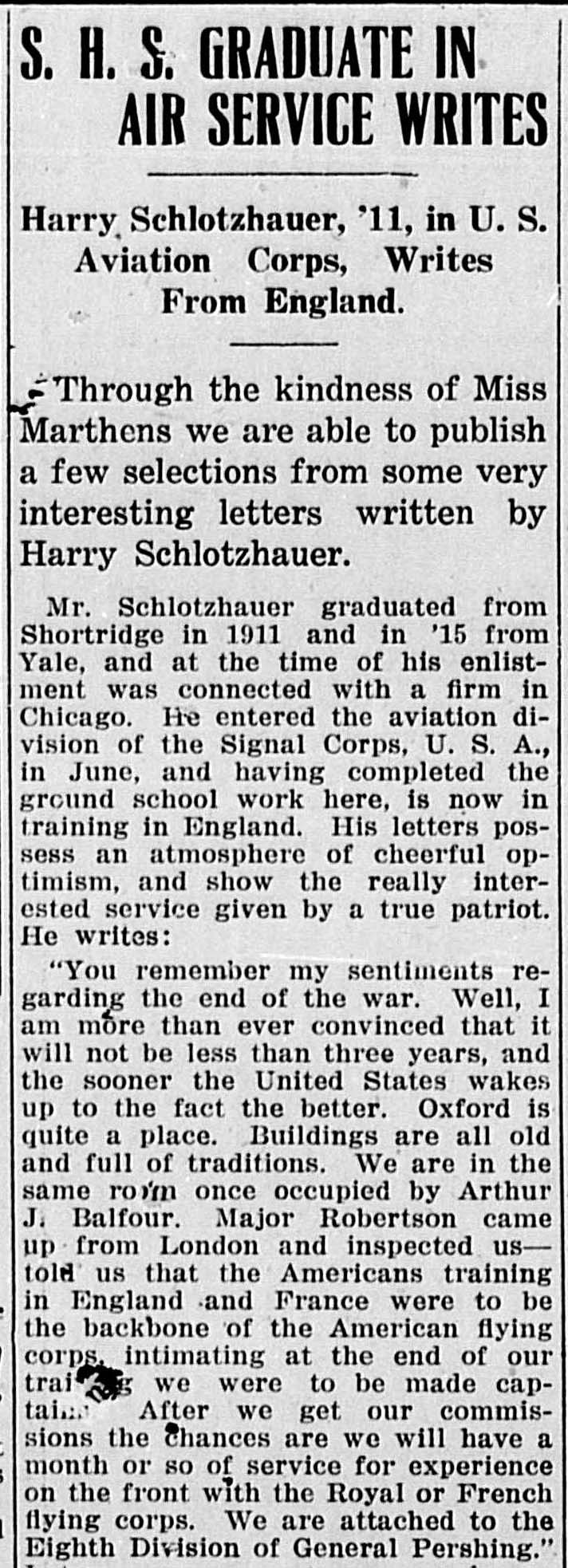
When, after an uneventful crossing, the Carmania docked at Liverpool on October 2, 1917, the cadets found that they would not continue on to Italy, but would remain in England and attend ground school (again) at the Royal Flying Corps’s No. 2 School of Military Aeronautics at Oxford University. Initially disappointed by the change of plans, the men soon became reconciled to it. Their British instructors, unlike the ones in U.S., had had war flying experience, and this added considerable interest to the course work. Since the men had already covered much of the material, they did not have to study especially hard, and they enjoyed Oxford hospitality and explored the town and surrounding countryside. The cadets were divided into two unequal groups: sixty were housed in The Queen’s College and ninety in Christ Church College—Schlotzhauer was apparently among those at Christ Church.10
The R.F.C. encouraged athletics, and Schlotzhauer enjoyed rowing. His fellow second Oxford detachment member William Ludwig Deetjen wrote in his diary towards the end of October that “We went out on the river today, and I stroked our crew of [Phillips Merrill] Payson, Schlotzhauer, [Joseph Frederick] Stillman & [Alexander Miguel] Roberts coxswain. We never knew when we left Exeter that we were in for a final race. Well we just naturally pulled the bottom out of the river and won by two boat lengths from Corpus Christi. We were given passes tonight as a reward.”11 All the men were by this time housed in Exeter College. Three weeks into October, the men of the first Oxford detachment—a group of fifty American cadets who had arrived in early September—staged a bibulous celebration of the end of their course, with some men of the second joining in. The British commandant in charge of the school was annoyed and insisted that all the Americans be reassigned to a single college, Exeter, and there they remained until early November.12
The men were eager to start flying training, but more disappointment was in store for most of them. The R.F.C. was able to accommodate twenty men from the detachment at No. 1 Training Depot Station at Stamford, but the others were sent on a machine gun course at Harrowby Camp near Grantham in Lincolnshire. As Parr Hooper, also sent to Grantham, remarked: “It looks like we got sent here because there was no other place to send us to—playing for time.”13
The day after they arrived at Grantham, Schlotzhauer joined some of his Illinois ground school classmates—John McGavock Grider, Laurence Kingsley Callahan, and John Warren Leach—in a trip to nearby Notthingham for supper.14 Such excursions were apparently a regular occurrence: Grider kept a photo of a group of men that includes the ones just mentioned plus several others, all Illinois ground school graduates, setting out from Grantham for Nottingham.
At Grantham Schlotzhauer missed “the opportunity of rowing afforded by the Thames, and the lack of exercise is beginning to show in the form of some extra weight. In addition, we get plenty of sleep, lots of fresh air and four good meals a day.”15 The men spent much time outside on the machine gun range; for the first two weeks they were learning about and practicing on the Vickers machine gun. Around the middle of the month, “We were informed . . . that fifty of us were to be posted in flying school sometime this week. Of course that sounded ‘like music unto my ears,’ but the list was published . . . and my name was not there. I wish I could feel as some of the boys do—really not care whether they fly or not, but I volunteered for that purpose, and I am going to—some day.”16
The following two weeks were devoted to the Lewis machine gun. Schlotzhauer much later recalled the frustration of being made to mark time at Grantham, but also that “one of the requirements of graduation was that we could assemble and disassemble both the Lewis and Vickers guns blindfolded. And as far as I am concerned that saved an awful lot of lives knowing what and how to do with a machine gun, particularly at altitude when it was cold.”17
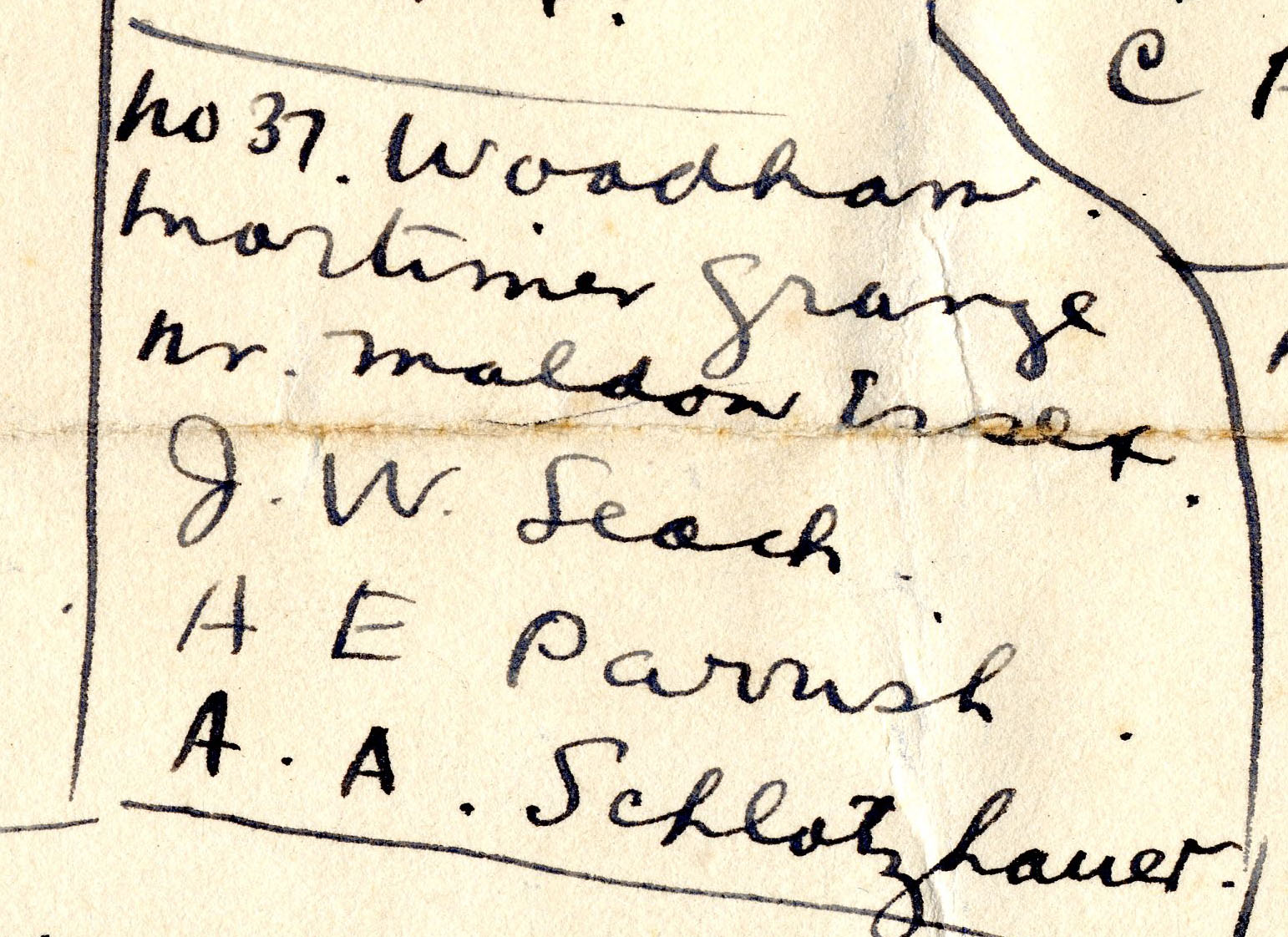
On November 29, 1917, with the blessing of the British authorities, the Americans at Grantham celebrated Thanksgiving in great style with a football game and a feast; quite a few of the fifty men already posted came back to Grantham to join in. Finally, on December 3, 1917, the men still at Grantham were assigned to squadrons. Schlotzhauer, Leach, and Albert Elliott Parrish, who had all been at the University of Illinois ground school, were posted to “No. 37 Woodham Mortimer Grange nr. Maldon Essex.”18
Training to fly
No. 37 Squadron R.A.F., commanded by Frederick William Honnet, was a home defense squadron charged with defending London against German air attacks from the east; like some other H.D. squadrons, it also provided flying instruction.19 Its headquarters was at The Grange, just west of the small village of Woodham Mortimer in Essex, and its three flights were based at airfields at nearby Stow Maries and Goldhanger.20 The squadron had on hand B.E.12s, single-seat aircraft designed for reconnaissance and bombing, as well as B.E.2d’s and B.E.2e’s, two-seater planes that had been used operationally in France through early 1917, but were now considered obsolete.21
Schlotzhauer was enthusiastic about his training at No. 37:
This flying game is without a doubt the greatest sport which was ever invented. It is really the life, and I wouldn’t have missed it for anything. The type of men in the R.F.C. is quite a revelation. I don’t believe I have ever met a crowd of men who are such universally good sports as these. Our commanding officer has been exceptionally nice to us and has done everything in his power to make us comfortable and to show us everything. He is a South African and has incidentally done eighteen months over the lines. I never believed that such men existed outside of fiction, for he is a real man. We are trying to arrange it now to have our final training in France under him.22
On December 4, 1917, at No. 37, Schlotzhauer made his first flight: fifteen minutes in a B.E.2e piloted by Frederick Sowrey, the officer commanding B flight at Stow Maries.23 By early January 1918 Schlotzhauer had made eighteen dual flights with a variety of instructor-pilots from both Stow Maries and Goldhanger, including with squadron C.O. Honnet, and with the C flight O.C., William Sowrey, brother of Frederick (nearly fifty years later Schlotzhauer recalled that Bill Sowrey taught him to make a sideslip landing24). On January 7, 1918, at Goldhanger, Schlotzhauer flew solo for the first time: he made two fifteen minute flights in a B.E.2e.
The page of Schlotzhauer’s log book that would cover most of January 1918 is missing from the copy available to me, but his flying over the course of January presumably resembled that of Leach.25 The latter continued to put in a good many hours solo on B.E.2e’s, and, towards the end of the month apparently completed both his height and cross-country tests, two of the requirements for graduation from the first stage of R.F.C. training.
At the end of January the three American pilots in training at No. 37—Schlotzhauer, Leach, and Parrish—along with a number of other men from the second Oxford detachment, were transferred to No. 5 Training Depot Station at Easton on the Hill, just southwest of Stamford; there were also men from the detachment nearby at No. 1 T.D.S. at Wittering, southeast of Stamford.
In the first part of February, at 5 T.D.S., Schlotzhauer resumed flying B.E.2s solo, and also twice flew a DH.6, a plane designed for instructional purposes and generally flown by students destined for reconnaissance or bombing squadrons. On February 17, 1918, he went up for the first of several flights in a B.E.12, and on February 21, 1918, he flew dual in an R.E.8. On the last day of February Schlotzhauer flew R.E.8 [A4]557 solo for fifty five minutes, making three landings, thus fulfilling the R.F.C. graduation requirement to have “flown a service machine satisfactorily.”26 (Leach had completed this requirement the previous day). By the end of the day on March 3, 1918, Schlotzhauer had flown twenty hours solo (he had fallen behind Leach in this respect), and this presumably meant he had qualified for his commission as a first lieutenant.27 The recommendation for his commission was forwarded from A.E.F. G.H.Q. to Washington on March 11, 1918; the confirming cable is dated March 22, 1918.28
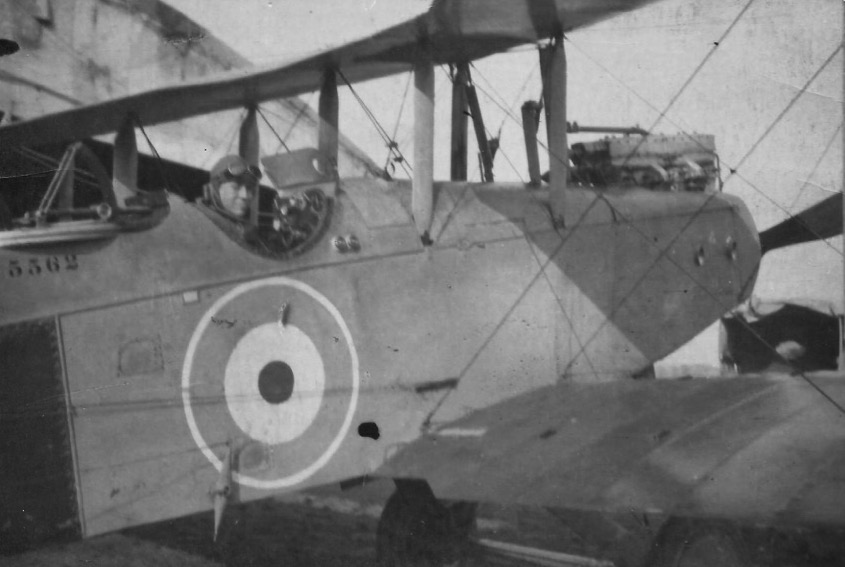
Schlotzhauer, along with Leach and perhaps Parrish, was transferred within No. 5 T.D.S. from 2 flight to 6 flight. For five days he continued to fly familiar planes, but on March 14, 1918, he went up for the first time in a DH.9 ([C]6117), with pilot and 6 flight commander George John Scaramanga. After this introductory thirty-minute dual flight, Schlotzhauer immediately went back up and flew the same DH.9 solo for an hour. He flew it again the next day, as well as “DH4 5562.” On March 17, 1918, he records flying the same DH.4 5562 in a formation flight of seventy-five minutes to Waddington, some of it at 10,000 feet, with a return flight to Stamford later in the day; a few days later he records a DH.4 solo flying time of “2 hrs. 45 min.” The DH.4 entries are puzzling, as there was no DH.4 5562 (with or without letter prefix), but there was a DH.9 D5562, and there is also a photo of Schotzhauer in the cockpit of a plane marked “5562” that is clearly a DH.9.29 The two DH.9s he flew during this period—C6117 and D5562—were manufactured by different companies and perhaps different enough to prompt Schlotzhauer to designate the latter a DH.4.

The subsequent page of Schlotzhauer’s log book is lacking in the copy I am able to consult, but his next posting was evidently to the No. 4 School of Aerial Gunnery at Marske-by-the-Sea in Yorkshire;30 Leach was posted there on March 22, 1918.31 Schlotzhauer’s R.A.F. service record lists the Bristol Fighter among the planes he flew during training, and it was almost certainly at Marske that he, like Leach, flew this plane.
Schlotzhauer’s final training posting was the No. 1 School of Navigation and Bomb Dropping at Stonehenge near Salisbury in Wiltshire; Leach’s R.F.C. Training Transfer Card indicates he was posted there on April 9, 1918, and both he and Schlotzhauer, according to their log books, began flying there three days later. They were initially back on B.E.2e’s for most of the month, practicing bombing and cloud and formation flying, with an interim period of no flying, perhaps for ground work, perhaps because of bad weather. Just before this no-flying period, Schlotzhauer had the unusual experience of being taken on an extended night flight to Southampton and back in a Handley-Page—the huge plane that took a crew of four and was designed for night flying and bombing. Towards the end of the month Schlotzhauer switched from B.E.2e’s to DH.9s; again he practiced bombing and cloud and formation flying as well as aerial fighting. On what was probably his final day at Stonehenge, May 14, 1918, he flew four times, for a total of nearly four hours of mainly formation flying; on the last flight he acted as deputy leader of the formation. His log book indicates he now had almost sixty-two hours of solo flying, just over twenty-four of them in DH.9s.
Although there is no record of ferrying in the copy of Schlotzhauer’s log book available to me (there may again be a page missing), it is almost certain that he, like Leach spent some time as a ferry pilot, moving planes from one station to another within England and perhaps ferrying new planes to France; Schlotzhauer later recalled going, after completing training, to “the pilots pool, which entailed ferry work.”32 Finally, his orders to report to the Air Ministry on May 24, 1918, was issued by the Central Despatch Pool.

France and No. 206 Squadron R.A.F.
The entry for May 25, 1918, in the diary of Joseph Kirkbride Milnor, a second Oxford detachment member who was working a desk job in London, reads in part: “Up at 6:00 in time to see Doug [Stier] leave in a side car. He leaves for France at 7:30 with Leach, Hash [Harold Hatch Gile], Schlotz, and two others.” Gile (of the first Oxford detachment), Leach, and Hugh Douglas Stier (of the second) were posted to the pilots pool at Rang du Fliers, but Schlotzhauer went directly to No. 206 Squadron—where Leach and Stier joined him on June 1 and June 6 respectively.33
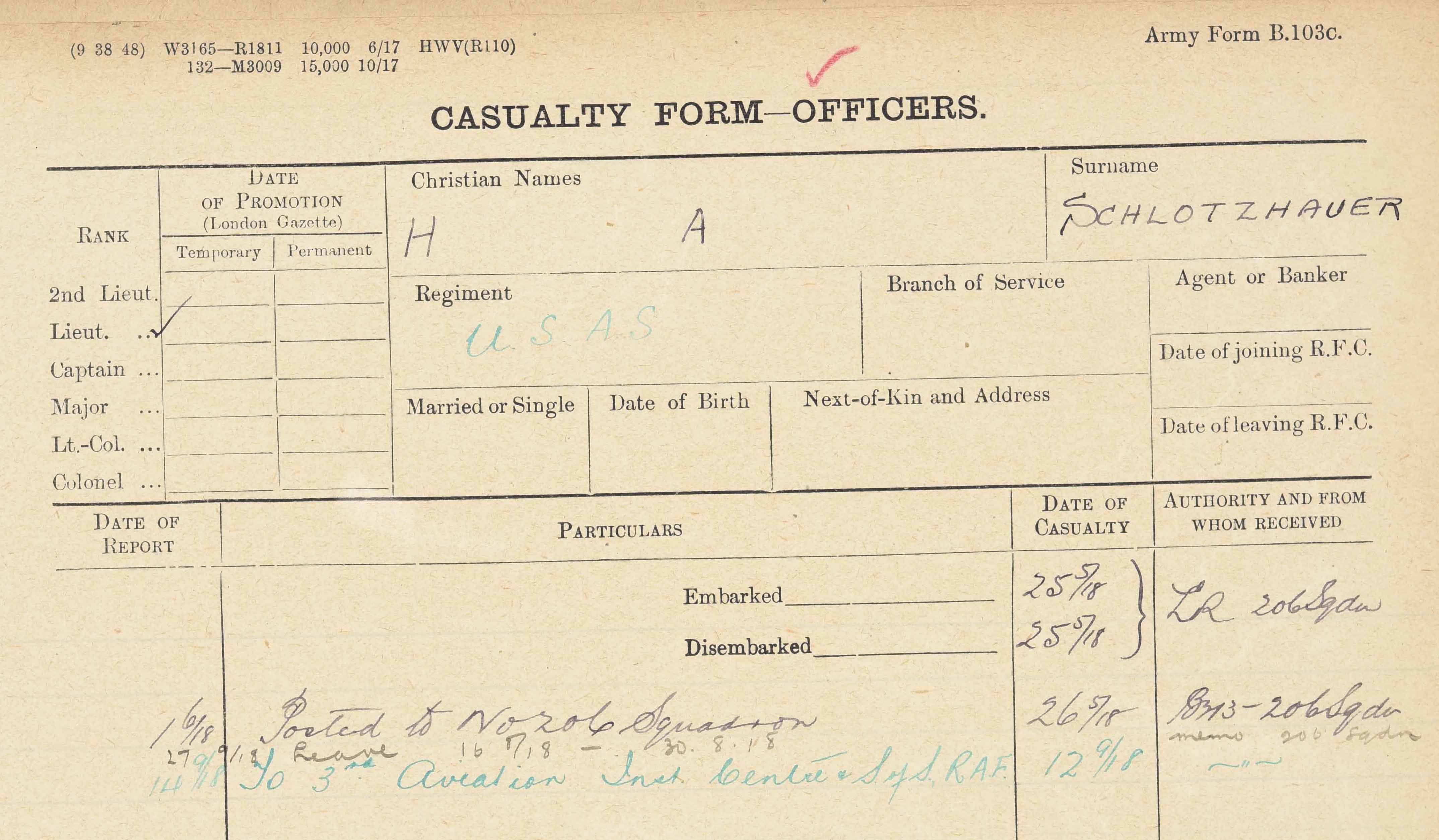
No. 206, a DH.9 squadron, commanded by Colin Temple MacLaren, was in the R.A.F.’s 11th Wing, which was attached to II Brigade, supporting the British 2nd Army commanded by Herbert Plumer in northern France and Flanders. John Stephen Blanford, an observer who arrived at No. 206 three days after Schlotzhauer, describes the squadron’s area of responsibility: “our sector of operations, which was in fact the 2nd Army Front, ran from Houthulst Forest, 10 miles north of Ypres down as far as Nieppe Forest, 20 miles SW of [Ypres]—roughly 30 miles in all.” He notes that the war on the ground at this time was relatively quiet. “In the air, however, there was still no lack of activity, and all 11 Wing squadrons were in the air whenever the weather permitted flying.” Enemy aircraft seldom entered Allied territory, so “all our encounters with the enemy took place over their territory.”34 The squadron was tasked with tactical bombing, reconnaissance, and photography.
The squadron was stationed at Alquines, about eleven miles west of St. Omer, when Schlotzhauer arrived on May 26, 1918, but on May 28, 1918, moved for a brief period to nearby Boisdinghem before returning to Alquines on June 5, 1918. In 1966 Schlotzhauer recalled that “The morning after I arrived at 206—the C.O. was very courteous—[he said] ‘spend a week and just fuss around above [?] the lines, but don’t get caught, just get to know the territory, do anything you want, but don’t get into trouble.’ Don’t get shot down, in other words.”35 That day Schlotzhauer flew DH.9 B7596 around the aerodrome; the next day he flew to St. Omer and Marquise. On the 29th he made two brief morning flights ferrying planes to Boisdinghem, but then almost immediately, still flying B7596, took part in a bombing raid on Comines, approximately forty miles due east of Alquines and over ten miles into German held territory; the mission lasted over two hours, some of it flown at 15,000 feet. Blanford recalled that A flight, to which he was assigned as an observer, needed to be brought (back) up to strength, and this may account for Schlotzhauer, also assigned to A flight, taking part in a mission a scant three days after his arrival.36
Leach, in a letter written not long after he arrived at 206, describe how “We go over the lines in formations of five to twelve machines, and do our work. . . . We fly from 15,000 to 20,000 feet now—four miles high. We have to take oxygen with us, for we are up from two to four hours at a time.”37 Blanford describes an occasion when he and his pilot “had recourse to our primitive oxygen apparatus. This involved sucking the stuff through a rubber tube that always tasted foul. I doubt if this really did us much good, as we were both feeling rather groggy by the time we began to lose height after re-crossing the lines.”38 Another pilot, Edward Trevor Evans, noted that the squadron was “situated a long way behind the lines—about 25 miles—so that to get our height (say 13,000 feet) and to get to the lines alone will take us an hour and a half.”39
Blanford writes of daily missions with A flight during the first two weeks of June 1918, the majority being bombing raids targeting rail and road bridges over the River Lys at Comines; this is borne out by Schlotzhauer’s log book, although after June 4, 1918, he for a time stopped recording the targets of the bombing raids. On June 5, now flying DH.9 B7678—which would remain his plane on the majority of his missions with 206—he flew a midday reconnaissance out of Alquines, but the next day began once again flying daily bombing missions, interspersed with a photography mission at 16,000 feet on June 9, 1918.
Leach, meanwhile, in B flight, was also participating in bombing raids; on the 10th 11th, and 12th B flight targeted Courtrai, even farther east.40 Schlotzhauer took it upon himself to write Leach’s mother when Leach was wounded in the shoulder on the 12th:
Since starting this letter I have seen Warren again. Upon first examination after the accident, the doctors were doubtful as to whether the arm could be saved or not. I worried a great deal as to what steps I could take to do the most good. Above all I wanted an American surgeon’s opinion. So I went straight to Major [Horace] Binney, the head surgeon at the Harvard Medical unit, and incidentally as I have since found out, quite an authority on the subject. He very kindly consented to go, and his opinion is very optimistic, I am glad to say, . . . the arm will ultimately be quite all right, with the exception of being a little stiff in the movement at the shoulder.41
Schlotzhauer apparently did not fly June 12, 13, or 14, 1918, but resumed taking part in bombing missions on the 15th. By the end of the day Sunday, June 23, 1918, Schlotzhauer had flown nearly forty hours in France and had flown nineteen missions, of which sixteen were bombing raids. Curiously, he does not supply the name of his observer for any of the flights during this period.
Starting on June 25, 1918, however, his regular observer / aerial gunner was Horace Walter Williams. In the remarks column of his log book for an unsuccessful (“washed out”) bombing raid that day with Williams, Schlotzhauer notes “dual and three landings.” Remarks Schlotzhauer made many years later probably explain this. In recounting his time with 206 and flights at high altitude, he recalled fearing he might fall asleep; for this reason, “I taught my observer to fly, I taught him to land.”42 On the 25th he was presumably having Williams fly and land the dual-control plane. It is also worth noting that when Leach was wounded, his observer, James Chapman, brought the plane back to friendly territory safely; this may also have raised awareness of how useful it could be to have an observer who could fly and land.
The next day Schlotzhauer and Williams took part in a bombing raid on Comines; over the next four weeks their targets included Courtrai, Halluin, and Roulers; they also did line patrols, and on two occasions escorted planes on high reconnaissance at 18,000 feet. For a brief period from July 8 through July 12, 1918, bad weather precluded flying. When missions resumed there was, according to Blanford, despite continued quiet on the ground, “a marked increase in enemy fighter activity. . . . the famous ‘Circus’ originally led by von Richthofen and now by Hermann Goering, was paying our sector a visit.”43 Sometime during this period Schlotzhauer was appointed deputy leader of A flight.44 According to Blanford, who was observer to A flight leader Rupert Norman Gould Atkinson, Schlotzhauer “flew just astern of Atkinson and myself on many raids, and I still recall making rude gestures to him on occasion, which he acknowledged with a broad smile. This illustrated how tight our formations were in those days.”45 On July 17, 1918, perhaps while Atkinson and Blanford were carrying out “an unofficial trench strafe,” Schlotzhauer served as A flight’s leader during an unsuccessful (“washout”) bombing raid.
July 29, 1918
On July 29, 1918, Schlotzhauer and Williams, flying DH.9 D5590 rather than their usual B7678, took part in an early morning bombing raid on Courtrai during which the planes of No. 206 were attacked by Pfalz aircraft. Schlotzhauer recalled “how worried MacLaren was over his lack of experienced personnel in making up the roster for the late afternoon raid on Courtrai, and when he asked me if I would double-up and go, there is always only one answer, and that is ‘Yes Sir’.”46 Eight planes from 206 Squadron took off shortly before 6:00 p.m. on “the afternoon raid.” Schlotzhauer and Williams, were once again in DH.9 B7678; other pilots included second Oxford detachment member Galloway Grinnell Cheston, who had joined the squadron at the end of June. Schlotzhauer recalled that
the specific target [was] the railway sidings at the southwest outskirts of [Courtrai]. There were seven [sic] of our machines in formation flying at about 15,000 feet. . . . As a rough estimate I should say that we were attacked about 7 P.M. by a squadron of 30 Huns made up of Fokkers and Pfalz who were flying the colors of the old Richtoffen [sic] Circus. They attacked from about 2,000 feet above us while we were over the town of Bissigham [sic; sc. Bisseghem], just prior to dropping our bombs. Immediately after reaching our objective and letting go of our bombs, we turned in formation and being so pitifully outnumbered, made a bee-line for Ypres.47
According to Blanford, “In the ensuing combat, 206 shot down four Pfalz, a notable feat achieved at some cost. Schlotzhauer and Williams were badly shot up and had their oil pipe broken; Williams was hit in the left arm, but despite this he kept his guns in action until all his ammunition was exhausted, shooting down one Pflaz [sic] in the process.”48
Schlotzhauer recalled that
after the first shock of realising that I was still alive I raised my glasses and found I was covered in oil and the pressure had dropped to zero. We had been shot through the oil tank. It was then that my knowledge and experience with internal combustion engines stood me in good stead—babying that engine down without the pistons or main bearing freezing. . . . The best thing [Williams] did at that moment was to toss over the empty Lewis drums, in hopes that they would get into the slipstream of the Huns and crash their propellers—and they were that close, believe me.49
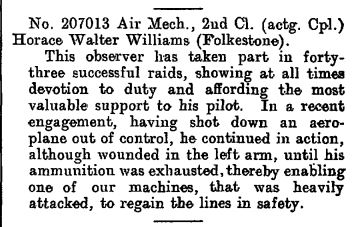
Back in Allied territory west of Poperinge Schlotzhauer saw a large red cross signifying a field hospital “with fields galore around it, . . . I got low enough to see telegraph wires and ditches, but the dear old Siddeley Puma [engine] gave two final gasps and froze.”50 He made a forced landing at Roesbrugge, and Williams was taken to the field hospital.51 Schlotzhauer and Williams were credited with destroying a Pfalz fighter at 7:40 p.m.; pilot Raymond Henry Stainbank reported seeing it crash near Ledeghem, a few miles west-northwest of Courtrai.52 Williams, who recovered from his injuries, was later awarded the Distinguished Flying Medal.53
The victory tally for this raid was remarkable, especially for a bomber / reconnaissance squadron. Blanford recalls “four Pfalz,” but the final tally was five Pfalz III destroyed (crashed or in flames), and there was a further plane “out of control,” as well, perhaps, as one “in a spin.”54
In addition to the injured Williams, the “cost” of the mission was Cheston and his observer Joseph Woodley Pacey, both killed in action, and a severely wounded Leslie Holman Rowe, Frederick Albert Brock’s observer.55
Late July, August, and September 1918 at 206
It must have taken some nerve to go out on another bombing raid the next day, as Schlotzhauer did. His usual plane, B7678, was either undergoing repairs and/or needing to be ferried back to the aerodrome. Instead he flew D1024; his observer was Chapman, the man who had flown the wounded Leach back to safety. Schlotzhauer’s log book does not indicate their objective that day, only that they flew for just over 2 hours, part of the time at 14,500 feet—very much like the previous day—and that there was “bad mist,” presumably hindering the accuracy of their bombing. Schlotzhauer flew yet again on the last day of July; this time he was on a photo mission and his observer was the man who would fly with him for the remainder of his time at 206, Marcus Glanfield Penny.
In the first two weeks of August, Schlotzhauer and Penny flew ten missions; by the third mission, on August 7, 1918, Schlotzhauer was once again flying B7678. All but the last of these missions involved reconnaissance and photography; this is presumably the work Schlotzhauer recalled nearly fifty years later when he said of No. 206 Squadron that “we were primarily [an] army reconnaissance squadron for General Plumer . . . General Plumer would call up and say he wanted such and such, and we did the job whether it was reconnaissance or photographs.”56 On August 14, 1918, Schlotzhauer and Penny took part in a bombing raid on Estaires.
From August 16–30, 1918, Schlotzhauer was on leave, as was Blanford; given their friendship, it seems likely that they spent some of their leave together.57 Back at 206 Schlotzhauer flew five more missions: two on September 1, one the next day (described in Schlotzhauer’s log book as “Special Photos of raid on Lindelle [Linselles?] Aerodrome”), and two on September 3, 1918; all involved reconnaissance or photography. On the September 3 another second Oxford detachment member, Clayton Knight, joined the squadron. Then, a week later, according to Paul Stuart Winslow of the first Oxford detachment, “orders came through for thirteen of us,” including himself, Stier, and Schlotzhauer, “to report to No. 3 Instructional Center at Issoudun.” On September 11, 1918, according to E. Trevor Evans, No. 206 Squadron “had quite a jolly evening,” a farewell party for Schlotzhauer and Stier, “two topping American officers who have been with our Squadron some time.”58
Issoudun, the 91st Aero, and home
According to Winslow the men posted to Issoudun “Reported to Headquarters and were told to come back tomorrow. We are worried about what is going to happen to us. When we reported to Major [Thomas George] Lamphier [sic; sc. Lanphier], we were told that we were ordered here by mistake, and they did not know what to do with us, but would wire Tours and let us know tomorrow.”59 Some of the men remained at Issoudun, three of them becoming instructors; some, Winslow reports, were sent “to Clermont,” presumably No. 7 A.I.C. at Clermont-Ferrand. Schlotzhauer evidently remained for a time at Issoudun: his log book shows him making a brief “joy ride” with “Lt. Benson” in a DH.9A at Field # 7 at Issoudun on September 15, 1918—this was presumably second Oxford detachment member Leslie Alfred Amzia Benson, who was an instructor at Field # 7. The next day, as a passenger, Schlotzhauer flew from Issoudun to Tours—perhaps for clarification of his orders. The next, and last, flight recorded in Schlotzhauer’s log book took place on September 25, 1918, when he made four landings in a Salmson. From Issoudun Schlotzhauer was evidently posted to the (American) 91st Aero Squadron; he appears as a pilot on the roster of that squadron for the period September 27–October 26, 1918.60
The 91st Aero was an observation squadron that in early September 1918 was assigned to the American First Army’s Army Observation Group; it was tasked with doing reconnaissance and photographic work well behind enemy lines. Flying Salmson 2 A.2s, the 91st had taken part in the Battle of St. Mihiel. Shortly before Schlotzhauer’s assignment the squadron moved to Vavincourt in preparation for the Meuse-Argonne Offensive. The nature of its work meant its planes often encountered and engaged enemy planes, and, despite not being a fighter squadron, the 91st racked up an impressive number of victories, while also losing a number of members in combat. I have found no information on Schlotzhauer’s activity while with the 91st; his name does not appear on the operations orders and reports for the relevant period.61 The 91st Aero also does not figure in Schlotzhauer’s recorded recollections from 1966.
According to James J. Sloan, Schlotzhauer was admitted to hospital on October 26, 1918.62 I have not found Sloan’s documentation for this, but Schlotzhauer’s departure for the U.S. around the time of the armistice on the George Washington, which transported mainly sick and wounded, may corroborate this; the ship arrived at Hoboken Nov. 19, 1918.63
Schlotzhauer resumed his career in banking, initially in Indiana, and then in Buffalo, where he was residing when Blanford visited him in 1935. Schlotzhauer served in the army once again in World War II; he returned to Buffalo but eventually moved to San Francisco. He and Blanford kept up a correspondence, and Schlotzhauer assisted the latter with his history of No. 206 Squadron.64
mrsmcq August 29, 2023; updated with Burrows materials November 6, 2023
Notes
(For complete bibliographic entries, please consult the list of works and web pages cited.)
1 Schlotzhauer’s place and date of birth are taken from Ancestry.com, U.S., World War I Draft Registration Cards, 1917–1918, record for Harry A Schlotzhauer Jr. His date of death is taken from Ancestry.com, U.S., Department of Veterans Affairs BIRLS Death File, 1850-2010, record for Harry Adam Schlotzhauer. His place of death is taken from John C. Anderson, “Harry Adam Schlotzhauer Jr.”; the same source indicates Schlotzhauer was buried in Indianapolis. The photo is from Schlotzhauer’s American Expeditionary Forces identity card, presumably issued in September 1918, when he left the R.A.F. and was reassigned to American aviation. The photo appears, however, to be from earlier, as it shows him without his pilot’s wings. The identity card can be seen here; Peter L. Burrows has the original, and I thank him for a copy of the document and permission to reproduce it.
2 Information on Schlotzhauer’s family is based on documents available at Ancestry.com and references to the family in the Indianapolis Star in the 1910s.
3 This is based on numerous mentions of Schlotzhauer in Shortridge High School’s newspaper, The Daily Echo, from the relevant time period, which has been digitized as part of the Indianapolis Public Library Digital Collections. Schlotzhauer’s draft registration, cited above, describes him as tall.
4 Moore, Phillips Academy, Andover, in The Great War, p. 308.
5 See Pot Pourri and Class Book 1912, p.116, regarding Schlotzhauer and the classical department. On his Yale attendance, see Nettleton, Yale in the World War, vol. 2, p. 413. I have not been able to ascertain the exact dates of Schlotzhauer’s attendance at Phillips and Yale; dates in extant sources would have him attending both institutions at the same time. That he studied electrical engineering is documented in The National Archives (United Kingdom), Royal Air Force officers’ service records 1918–1919, record for Harry Adam Schlotzheuer [sic].
6 Schlotzhauer’s R.A.F. service record, cited above, lists Schlotzhauer’s employment with dates.
7 See his draft registration, cited above.
8 See Moore, Phillips Academy, Andover, in The Great War, for Schlotzhauer’s date of enlistment.
9 “Ground School Graduations [for September 1, 1917].”
10 Nettleton, Yale in the World War, vol. 2, p. 413, indicates Schlotzhauer was at Christ Church.
11 Deetjen, diary entry for October 27, 1917.
12 The celebrations of the first Oxford detachment and the aftermath are recounted in several diaries, as well as in the October 22, 1917, entry in War Birds.
13 Hooper, Somewhere in France, letter of [November] 4, 1917.
14 Grider, diary entry for November 6, 1917.
15 “S. H. S. Graduate in Air Service Writes.” This article contains excerpts from several letters from Schlotzhauer, with the promise “continued next week.” I have not, however, found a continuation.
16 Ibid.
17 Col. Harry A. Schlotzhauer, tape 1, side A, approx. 00:14:00.
18 See Fremont Cutler Foss’s list of “Cadets of Italian Detachment Posted Dec 3rd” in Foss, Papers.
19 On the commander of 37 Squadron, see Leach’s R.F.C. Training Transfer Card, as well as Philpott, The Birth of the Royal Air Force, p. 120 (with the variant spelling, “Honnett”).
20 One flight had previously been located at Rochford, but it was relocated to Stow Maries in July 1917. See Philpott, The Birth of the Royal Air Force, p. 251, and Red Gate’s post to “John Warren Leach, log book entry, 25 Jan. 1918—help decipher?”
21 That B.E.2s were nevertheless still used by the pilots of No. 37 is apparent from the Goldhanger Flight Station 1917 – 1918 Operational Records that can be accessed via a link at “37-Squadron Night Landing Grounds.”
22 “S. H. S. Graduate in Air Service Writes.”
23 For the locations and officers commanding the flights, see the end of Chapter 6 of Pitchfork’s The Sowreys. Unless otherwise noted, information on Schlotzhauer’s flying is taken from his Pilot’s Flying Log Book.
24 Col. Harry A. Schlotzhauer, tape 1, side A, approx. 00:16:00.
25 See Leach, Pilot’s Flying Log Book.
26 Schlotzhauer, like many pilots, did not provide the letter prefix when writing airplane serial numbers. In this case, however, he appears also to have left off the first digit; comparison of relevant entries at Pentland, Royal Flying Corps, and Robertson, British Military Aircraft Serials 1878–1987, has led me to conclude that he flew A4557.
27 I have found no official documentation of the requirements for a commission, but there was an understanding that a pilot had to have flown twenty hours solo; see, for example, Hooper, Somewhere in France, letters of December 28, 1917, and January 31 and February 14, 1918.
28 Cablegrams 715-S and 967-R.
29 I am grateful to Peter L. Burrows for a copy of this photo.
30 See Schlotzhauer’s RAF service record, cited above, which notes his presence at Marske on April 1, 1918; and Biddle, Special Orders No. 35, which indicates that Schlotzhauer was at Marske when he was assigned to active duty on April 4, 1918.
31 See Leach’s R.F.C. Training Transfer Card.
32 Col. Harry A. Schlotzhauer, tape 1, side A, approx. 00:20:00.
33 See their casualty forms: “Lieut. Harold Hatch Gile A.S.SIG RC US,” “Lieut. J W Leach USAS,” “Lieut. H D Stier USAS,” and “Lieut. H A Schlotzhauer U. S. A. S.”
34 Quotations are taken from Blanford, “Sans Escort,” pt. 1, p. 147. Blanford’s two-part article is one of the few extensive sources of information on No. 206 Squadron in World War I; the original squadron record book appears not to be extant. For a succinct summary of 206’s activities in the early part of 1918 (prior to Blanford’s arrival), see Bruce, “The De Havilland D.H.9,” pt. 1, p. 388. The chapters on 206 during this period in Gunn’s Naught Escapes Us, rely heavily on Blanford as well as a few other source documents in the 206 Squadron Archives. Document AIR 27/1221 in The National Archives (UK) includes merely a three and a half page summary of operations during the period.
35 Col. Harry A. Schlotzhauer, tape 1, side A, approx. 00:24:00.
36 Blanford, “Sans Escort,” pt. 1, p. 147; see ibid., pt. 2, p. 21, for Schlotzhauer’s assignment to A flight.
37 “Lieut. Warren Leach, Tuscaloasa [sic] Birdman, Tells in Letter of Air Fighting.”
38 Blanford, “Sans Escort,” pt. 1, p. 148.
39 “‘With Fondest Love, Trev.’,” letter of August 26, 1918.
40 See Leach’s log book for the raids of June 10 and 11. A newspaper account from December 1918 that is at least second-hand and in some respects not reliable (in “Camp Mills Ringing To-day”) indicates that Courtrai was the object of the raid on the 12th, and Blanford (“Sans Escort,” pt. 2, p. 24) records a raid on Courtrai on June 12, 1918.
41 Schlotzhauer’s letter is reproduced in “Warren Leach Received Bullet Wound in Right Shoulder, Says Letter.”
42 Col. Harry A. Schlotzhauer, tape 2, approx. 00:09:35.
43 Blanford, “Sans Escort,” pt. 1, p. 150.
44 Blanford, “Sans Escort,” pt. 2, p. 21.
45 Ibid.
46 Gunn Naught Escapes Us, p. 33, who cites from a letter Schlotzhauer wrote to Horace Walter Williams.
47 Schlotzhauer’s account is included as p. 58 of Cheston, World War I burial file. In his oral account from 1966, Schlotzhauer recalled an initial flight of eight planes, with one dropping out (Col. Harry A. Schlotzhauer, tape 1, side B, approx. 00:26:40).
48 Blanford, “Sans Escort,” pt. 1, p. 151. Note: Blanford himself did not take part in this mission.
49 Schlotzhauer’s letter to Williams, cited on pp. 33–34 of Gunn, Naught Escapes Us.
50 Ibid.
51 See Schlotzhauer’s log book for his forced landing site. The casualty card for Williams inaccurately gives his plane number as B7665 (the last digit is in doubt); see “Williams, H.”
52 See Individual Combat Records of Pilots with R.A.F., p. 36.
53 The citation can be read on p. 12977 of the Supplement to the London Gazette of November 2, 1918.
54 See “100 years ago today – 29 July 1918.” Sturtivant and Page, The D.H.4 / D.H.9 File, entry for D1689, notes “1 in spin.” (This entry mistakenly gives the date July 28, 1918, and apparently conflates events of July 29, 1918, with events of August 15, 1918, assuming the entries for D1689 at Pentland’s Royal Flying Corps for this plane are accurate.)
55 See “Rowe, L.H.” and Rowe, “206 Squadron RAF,” p. 26. There is evidently a document that, almost certainly mistakenly, gives the date of Rowe’s injury as July 27, 1918; see the entry for DH.9 C6289 in Sturtivant and Page, The DH.4 / D.H.9 File. Blanford, “Sans Escort,” pt.1, p. 151, mistakenly recalls that pilot John Frederick Spencer Percival and his observer Frederick James Paget were both wounded on this raid. They did take part and were credited with a Pfalz, but it was on August 1, 1918, that Paget, again flying with Percival, was mortally wounded. Percival sustained injuries on August 7, 1918, and died in early 1919; see the relevant entries in Henshaw, The Sky Their Battlefield II.
56 Col. Harry A. Schlotzhauer, tape 1, side B, approx 00:01:30.
57 “Lieut. H A Schlotzhauer U. S. A. S.”; Blanford, “Sans Escort,” pt. 1, p. 151.
58 “‘With Fondest Love, Trev’,” p. 151.
59 “Attached to No. 56,” entry for September 13, 1918.
60 91st Squadron, p. 18.
61 Ibid., passim.
62 Sloan, Wings of Honor, p. 184.
63 Ancestry.com, U.S., Army Transport Service Arriving and Departing Passenger Lists, 1910-1939, record for M A Schletzhauer [sic].
64 See information from census documents available at Ancestry.com, and Blanford, “Sans Escort,” pt. 2, p. 21.

